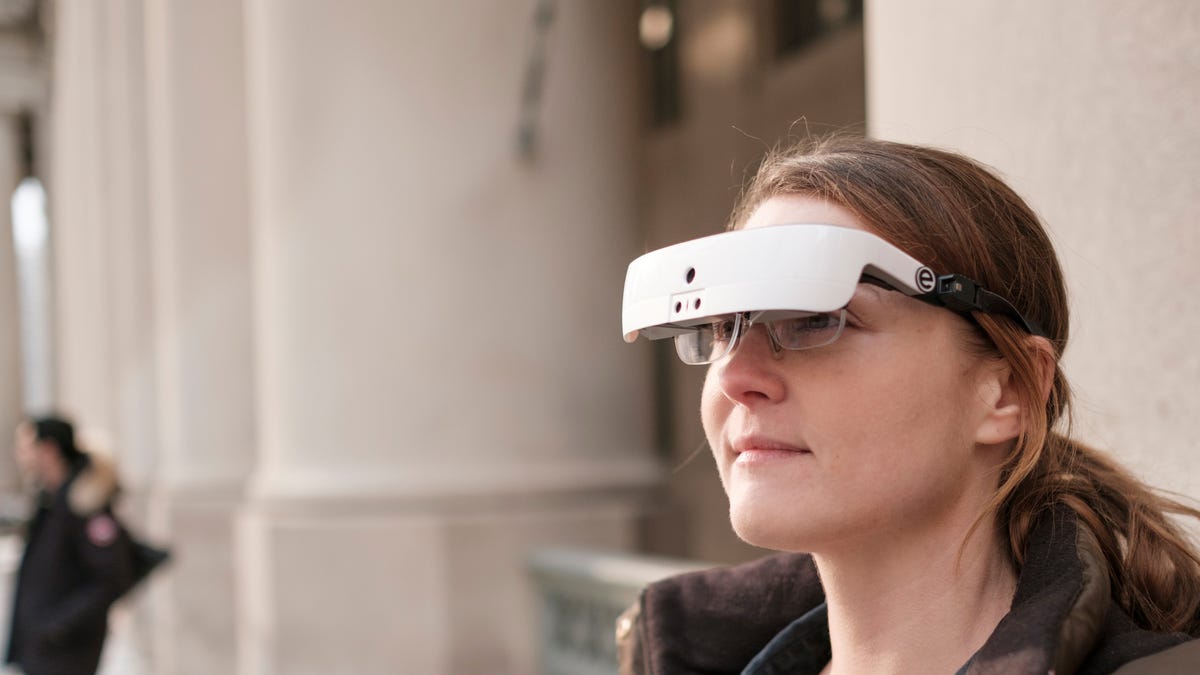This 'Star Trek'-like headset helps the legally blind see again
Almost like the VISOR in 'Star Trek,' the eSight 3 lets low vision wearers do almost anything, from reading a menu to playing basketball.

This is part of CNET's "Tech Enabled" series about the role technology plays in helping the disability community.
Yvonne Felix is walking toward me wearing a device that could be straight out of "Star Trek: The Next Generation."
Like Geordi La Forge in the science fiction series, Felix is legally blind. In the show, La Forge, played by LeVar Burton, wore a headset called VISOR that helped him see again. Felix is wearing its real-world equivalent, the eSight 3.
The eSight 3 has a camera that works with high-resolution displays and optical prisms in the headset to restore sight to those with low vision. The video image is presented to the user in a way that can overcome the cause of their vision loss.
"I remember putting them on and looking up and I saw my husband who I'd been married to for eight years and had never seen before," Felix tells me as we're looking over the San Francisco Bay. "And my 2-month-old son, who we had just brought home from the hospital and he was holding him and it was the most beautiful image, like it's burned in my mind for the rest of my life."
This headset can help solve many accessibility challenges the legally blind face.
This headset is an example of how accessibility issues are being solved with technology. It's an increasingly important topic, particularly for tech companies like Apple and Microsoft, who have been pushing to make products easier to use for low vision users. But these solutions still have limitations for the legally blind.
Felix lost her sight after being hit by a car when she was 7 years old. She was diagnosed with Stargardt disease, a juvenile form of macular degeneration. As a result, she has a blind spot that blocks 98 percent of her visual field.
Her condition is more suited to eSight than other low vision issues. Macular degeneration and sight loss from diabetes complications are more likely to benefit rather than glaucoma. In these cases, damage to the retina can be greater than eSight can resolve.
Regardless, anyone can give eSight a try. CEO Dr. Brian Mech explained that eSight has a better than 50 percent chance of working with all conditions.
"The beautiful thing is it's not surgical, it's not medication, it's not a drug. So you can just try it on."
A clearer view
The liquid lens technology inside the headset helps the camera focus incredibly fast: less than 1 millisecond, similar to the human eye. Combined with a feature Mech calls "bioptic tilt," wearers also get access to their peripheral vision which is important for tasks where you are mobile and moving.
Felix is a longtime user of the device that's currently in its third generation. She's worn previous versions for everyday tasks like shopping, banking and going to work, but she put it to an even more extreme test with vigorous activities like zip lining and riding a mechanical bull.
This controller lets the wearer adjust the image to their liking.
"There are a lot of people out there like me that are going through the same experiences of feeling alone, feeling isolated, and not being a part of the world visually," she said. "Being able to connect with people and your family, and getting out of your house and being part of the world again is something that I would think everybody would want."
A special controller connected to the headset lets wearers adjust the image to their liking. Manipulations include boosting the contrast (which can help edges and objects stand out) or zoom controls to enlarge text. The built-in light can illuminate the scene, useful for low-light situations.
Although eSight has slimmed down the visor from previous generations, Mech believes there's still room for improvement.
"I think the day will come where it's not so different than just a regular pair of glasses, or maybe even a pair of contact lenses," he said. "We're not talking 20 years from now, we're talking about maybe in the next five to 10 years."
The company is also looking at waterproofing future versions of the headset.
Other devices like magnifying glasses are certainly an option for the legally blind, but in most cases they don't actually improve vision or can only enhance vision for a specific task. Another option is a customized virtual reality headset that may help some low vision conditions.
For now, Felix is more than happy with the freedom she's been given with the headset, even if the design prompts questions and stares from curious onlookers.
When I walked through San Francisco's Ferry Building with Felix, at least two sales associates approached her to ask about the device.
"I love when people come up and ask me what I'm wearing because it's a door opener," she said. "It allows me to talk about low vision and that there are solutions and low vision hits everybody. You might not have it, but it doesn't discriminate."
CNET Magazine: Check out a sampling of the stories you'll find in CNET's newsstand edition.
Solving for XX: The industry seeks to overcome outdated ideas about "women in tech."

